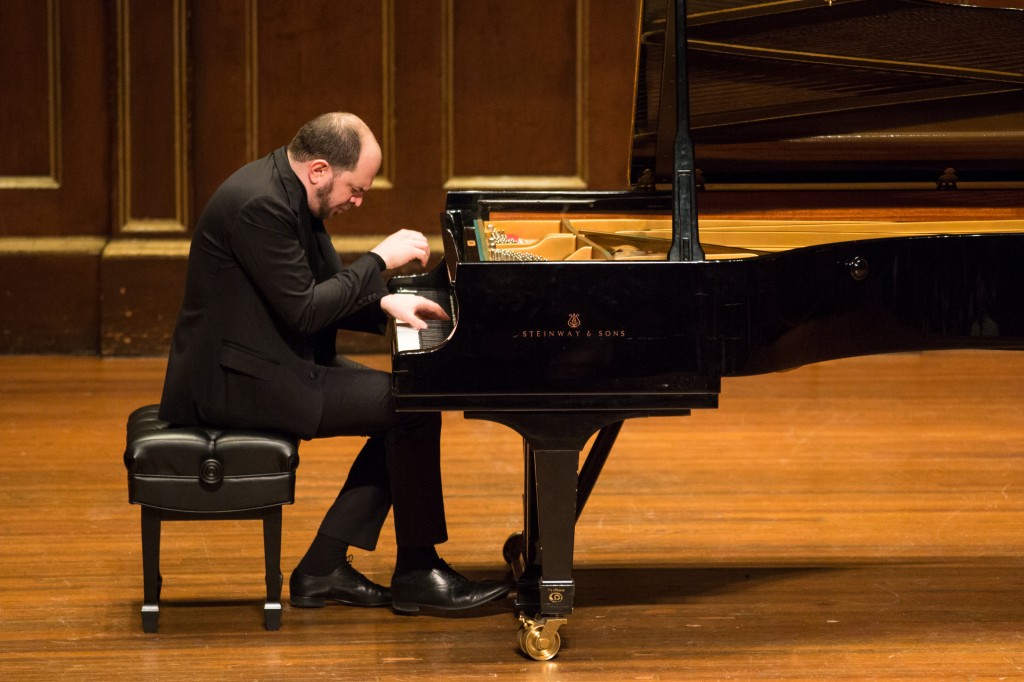Gerstein’s recital celebrates Romanticism, past and present

Kirill Gerstein performed at Jordan Hall Friday night in a recital presented by the Celebrity Series. Photo: Robert Torres
A rich vein of Romantic imagination ran through Kirill Gerstein’s piano recital at New England Conservatory’s Jordan Hall Friday night. It throbbed not just in those familiar yet forever strange piano cycles, Schumann’s Carneval and Mussorgsky’s Pictures at an Exhibition, but also in a protean late work by Haydn and a new piece by Timothy Andres, which had its Boston premiere Friday.
According to a note by the composer, the title of Andres’s one-movement work, Old Friend, referred to the pianist Gerstein, whom Andres trusted to understand his intentions in the piece, and also to a favorite piece from the past, Chopin’s Scherzo No. 3 in C-sharp minor.
The main theme of Old Friend, as persistent as the repeated bass line of a passacaglia, descended gently from high in the treble, like the striking shower-of-stars effect Chopin created in the middle section of his scherzo. (Coincidentally, the theme also seemed to mimic the limping gait of “Gnomus” in Mussorgsky’s Pictures.)
As realized by Gerstein, the piano sonority of Old Friend was also Chopinesque, lush and layered. Another favorite Chopin technique, expressive cross-rhythms, proliferated as the variations unfolded. Reveling in sounds from clanging octaves to the gentlest burbling, Andres’s piece seemed to celebrate the piano itself as a very old friend, born in the nineteenth century, with some good juice still in it.
The program opened with Variations in F minor, the remarkable work Haydn composed for the robust English pianos (and female pianists to match) that he encountered during his late-in-life London sojourn. Looking back over this program, so highly seasoned with Romanticism, one can understand why Gerstein inflected Haydn’s simple theme as if it were a Chopin mazurka; at the time, one wished he’d just let it be, and save the rubato effects for later.
Similarly, it was hard to understand at first why Gerstein seemed to back away from anything forte or emphatic in Haydn’s score, as if he were reviving the prissy, trivializing interpretations of this composer that used to be all too common. But eventually one understood that the pianist was emphasizing the inward-looking aspects of this music. The swimming syncopations of the first variation did indeed put one in mind of the next composer on the program, Robert Schumann, as did the passionate surge of the work’s long coda.
When the actual Schumann arrived, Gerstein’s Romantic aesthetic found an unquestionable fit. If the young composer’s imagination was all over the map, he certainly was in fascinating territory. The poetic waltzes of his idol Schubert were the springboard for this masked-ball scene, in which thinly disguised versions of the composer and his girlfriends, commedia dell’arte characters, and celebrities like Chopin and Paganini mingled on the dance floor.
Gerstein played this volatile music with all the necessary abandon, but also keen sensitivity to shifts in harmonic color and the natural interplay of voices in the music, like bits of overheard conversation. (Schumann later studied Bach’s fugues to learn counterpoint, but he already had plenty of it in his soul.) Nervous energy and speed characterized much of this interpretation, although Gerstein could also summon up classical grace and poise in the score’s Schubertian moments.
In fact, the pianist was alert to the expressive needs of every bar of this music. Schumann’s sensitive alter ego, Eusebius, never sounded more painfully shy than in his brief appearance amid the revels Friday night. The closing March of the League of David against the Philistines was as resonant and optimistic as one could wish, and while following the composer’s instructions to play faster and still faster in the coda, Gerstein never allowed the music to fly off the handle, but brought it to a splendid finish.
A “variations” thread was emerging in the program, leading from the Haydn Variations to Carneval (Schumann’s crypto-variations on letters in his own name) to the passacaglia-like character of Andres’s piece, and concluding with Pictures at an Exhibition, where variations on the recurring “Promenade” theme mirrored the composer’s changing state of mind as he viewed his late friend’s paintings in the gallery.
The prospect of an entire evening of theme-and-variations might cause eyes to glaze in some quarters, but not when a shape-shifting, transformational imagination is at work, as it was in Friday’s recital.
As Schubert was an inspiration to Schumann, so Schumann was to Russia’s Romantic avant-garde composers known as the Mighty Five, of whom Mussorgsky was in many ways the mightiest. As Gerstein made clear in his richly characterized performance, Pictures was the product of a Schumann-like creative burst—the composer described the music as “boiling” inside him—placed at the service of a Russian sensitivity to pathos, irony, the grotesque, and endurance in spite of it all.
The first requirement of any recital performance of Pictures is to establish that it really is a piano piece, not just a sketch waiting for Ravel to orchestrate it and put it on the map. This Gerstein did abundantly, turning to the big black “old friend” and finding the right tone color for every picture on the wall, be it landscape or portrait, and closing with a “Great Gate of Kiev” that was plenty sonorous without pushing the instrument beyond its limits.
The pianist responded to the audience’s enthusiastic applause with a single encore, a limpid rendering of Rachmaninoff’s Mélodie in E major, Op. 3, No. 3.
The next presentation of Celebrity Series of Boston is Schubert’s Winterreise with bass-baritone Gerald Finley and pianist Julius Drake, 8 p.m. Friday at New England Conservatory’s Jordan Hall. celebrityseries.org; 617-482-6661.
Posted in Performances